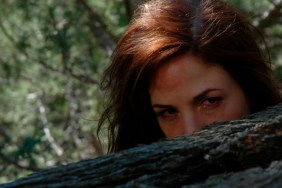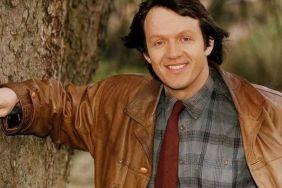Over the past ten years, Michel Gondry has gone from being one of the most talented music video directors in the industry to a film director whose name is synonymous with filmmaker-as-auteur. That hasn’t stopped him from collaborating with musicians by creating visuals for their songs, instead giving him even more freedom to use his creative imagination.
2003 was a big year for Gondry as the release of his second film Eternal Sunshine of the Spotless Mind was followed by the DVD compilation, “The Work of Director Michel Gondry,” part of the groundbreaking “Director’s Series” that included many of his best-known and award-winning music videos, including work with Bjork, Beck and The White Stripes. The combination of the two thing quickly made Gondry a favorite name-check among cinephiles and film school graduates.
It’s been over five years since then and Gondry has numerous feature films under his belt, as well as a second DVD collection called “More Videos: Before & After DVD 1” and it’s an even more eclectic batch than the original. Besides containing new collaborations with Bjork and Beck and the White Stripes, it also features his video for Sir Paul McCartney’s “Dance Tonight” and older videos culled from the archives. The part that Gondry’s fans will surely cherish are the behind-the-scenes docs about the making of six of those videos, as well as some of the more personal works including an animated short by his son Paul and a portrait piece on Ayako, the star of Gondry’s segment in the recent anthology Tokyo! (which may still be playing in some theatres.)
You can read more details and see the full tracklisting for the collection here, but it’s just one of the exclusives you can find at Gondry’s freshly-launched official site.
ComingSoon.net has talked with Gondry numerous times but never specifically about his music video work, so we got on the phone with him earlier this week to go over some of his selections for the second compilation.
ComingSoon.net: Were you more involved with this second collection than the first one?
Michel Gondry: No, no, the first one I was very involved, but actually, I was equally involved.
CS: There seems to be a lot more behind-the-scenes and more personal stuff than the last one.
Gondry: Yeah, we just decided to group all the behind-the-scenes and make sort of a documentary, because I didn’t want to have some sort voice-over stuff going over the video, and I thought it was more interesting to just group everything, so we put more behind-the-scene (stuff) on. Since the first DVD, we became more consistent in shooting the behind-the-scenes documentation.
CS: Has this behind-the-scenes footage been seen or shown anywhere before?
Gondry: No, it’s never been seen anywhere. It’s all new stuff.
CS: There’s a lot of variety in the videos on this collection; they cover a lot of early stuff but also very recent stuff. Is this basically everything that’s left that didn’t make it onto the first collection?
Gondry: I’m still doing some, and I could go even more in the past. There are a couple of them I still haven’t used. The one I did for Kanye West I couldn’t use because the rights situation with some part of it, so maybe it’s going to make it onto the next one.
CS: You’re one of the music video directors who has helped turn that medium into an artform. We’d often see artists or bands getting video compilations but not directors. After making a few successful films, you’ve continued to return to the music video realm. What’s the appeal when you’re obviously very busy making movies?
Gondry: I like this relationship I have with musicians, this sort of collaboration to extend the world that started with a song and give it a little bit of a second life. I have this guilt about “video killed the radio star,” it really will happen in some ways, but I think guilt is not a bad thing. It’s where the Freudian stuff is rubbish against guilt, because guilt makes you do something better than you would and when you do something bad and feel guilt, then you correct it accordingly and it’s your way to check if you’re right or wrong. This guilt of sort of destroying the medium in a way makes me try to make them as good as I could.
CS: The ones you do are definitely more artistic, because you do a lot of interesting things, whereas most of the time, videos are just being used as part of the marketing, while these are not.
Gondry: Yeah, I think they still are a marketing tool, but it’s how you put your trust in the market and the audience. If you think they’re dumb, okay, fine, then do a dumb video, but if you think they’re not so dumb, then you can do a not-so-dumb video. I always think I don’t want people to get bored. I want to keep the flow of (things) going until the end of the video and I have to be
considerate to sustain the whole video and find surprises or elements that carry your attention to the end. I’ve developed a technique for when a part of the song gets a little slow or repetitive or not so intense–I try to (work with) the musician, but generally, they don’t want to touch the music–so if it’s okay, I usually use the best idea I have for the whole video in this part to make sure the audience keeps being entertained while watching the whole video.
CS: On this collection, you have a couple videos with people you worked with before like Bjork and Beck, and then you have Paul McCartney who you were working with for the first time. Does someone like Paul McCartney come to you with ideas of what he wants to do or does he just put it in your hands? What’s the collaboration like with a new person you’re working with?
Gondry: Well, with Paul McCartney, he had this idea of the ghost basically, so I figured a way to make it interesting for me to do. The song was quite naïve and dispirited and of course, he’s a legend, so it was amazing to be able to work with him and more so when we did this sort of jam session at the end of the shooting where he played with me and everybody was dancing in the apartment. It was just surreal to be a part of that.
CS: I saw that on the extras, as well as when you go to jam with Booker T.
Gondry: Yeah, that’s a great luxury I have now because I have this recognition in the world of music and I can accomplish dreams that were completely not considerable initially. Playing drums with some of my favorite musicians ever is just incredible.
CS: I can imagine. When you do a video like “Walkie Talkie Man” or the Bjork video where there’s a lot of construction to be done, or a lot of knitting, how much time do you usually have in advance to prepare and put those videos together?
Gondry: It depends. It’s pretty rushed but for the Steriogram, I think we had three weeks or a month and Bjork was a little shorter. It takes a little bit of time and it’s not so much in post-production, it’s more in pre-production, which makes it more complicated because the schedule of the artist is so chaotic. To plan things a little bit ahead of time is complicated.
CS: For something like the Steriogram video, did you hear the song first and automatically think “Oh, this would work really well with yarn” or was that an idea you always wanted to do and that was the right opportunity?
Gondry: I thought of yarn years and years ago because I wanted to work with my mother, because she’s a great knitter, and I thought probably 20 years ago, “Okay, maybe I can do a video all knitted.” Well, that’s one of those ideas that I never did and it stayed in the corner of my eye, and then I met this artist Lauri Faggioni who was doing stuff with felt and yarn and I really liked her work, so I decided to collaborate on making the whole video with yarn and felt and fabrics. And then it was really fun, because I could do the cliché of the video when you see the band in the recording studio, and then recreate every scene with yarn. There were a million possibilities we could do with the yarn from the recording tape to the lighting of the projector, the strings of the guitar, the soundwaves, everything sort of turned into yarn. I think the idea works when it’s taken until the very end. You don’t use it as a gimmick at some point, you just becomes the whole video.
(You can watch that video here.)
CS: When you were going back to some of your older videos, were there things you hadn’t seen in 10 or 15 years that you revisited?
Gondry: Yeah, like the one for this band Energy Orchard, it’s okay. I was using a lot of blue screen at the time and you could tell that I was trying to manipulate the medium in a different way, but it’s far from being perfect.
CS: But you put them on this collection, so did you just want to show a variety of your work and weren’t worried about whether it was some of your better or worse than some of your better known videos?
Gondry: I mean, if people are interested in my work… I think of what I would be interested in if I looked at the work at somebody I like. I like to see where he started from or where he went and it’s interesting. If you take this point of view, it’s justified that you put work that’s not your best, but it just shows how your brain works. Some of these videos are not like a masterpiece but my will was honest and I was always trying to be truthful to the music and personal.
CS: What was the deal with the Rolling Stones video? I’d never seen that one before, but was that something done as a promo?
Gondry: That was a really long time ago and that was a show they played live, and the problem is that MTV once again never played it because they played the concert footage of the song. The video includes the brother who suddenly passed this year, (who was) sort of troubled when I worked with him.
CS: I also liked the short film you did with Ayako, the star of your segment in “Tokyo!” Was that something done for film festivals?
Gondry: I wanted in a way to promote “Tokyo!” with that, but it wasn’t used for that. It was my own idea how to promote the movie but it didn’t work with it. I’d done that because I thought she was very interesting and her relationship with her father was very unusual, and they were so different that you could barely imagine that they shared genes. It was interesting to see them together.
CS: When I saw “Tokyo!” I didn’t realize who her father was and when she was talking about her at the start, I didn’t even know. I guess most people know that but I didn’t.
Gondry: No, it’s not something she advertises.
CS: Do you have a lot of other videos since doing those or more you might do soon?
Gondry: In terms of videos, I think everything is in there. I don’t think I’m going to do a video soon, because I’m doing “The Green Hornet” and that’s taking all my time.
CS: What about the stuff you were going to do with Daniel Clowes, is that still going to happen sometime?
Gondry: Yeah, yeah, yeah, we (doing) a cartoon, an animated film that I co-directed with my son, called “Megalomania,” and it’s being produced by Curious Pictures in New York. Dan Clowes wrote the screenplay and we have Steve Buscemi doing the voice of the main character. I guess I will do that more efficiently after “The Green Hornet” but they already started to work on it.
CS: Yeah, I saw that your son Paul has a short animated piece on this DVD collection, too, and it’s neat that he’s following in your footsteps with the animation.
Gondry: He’s been doing comic books since he was 10 and he’s pretty amazing. He has tons of drawings and paintings, just a really strong artist.
CS: Do you think he might break into music videos himself soon?
Gondry: Well, we’re doing this movie “Megalomania” together, so I guess he’s going to probably continue on his own. He has this challenge to survive, (because) it’s always difficult when you have a father people know before they know you. I know it’s not easy so he has to find his way and he’s screaming his independence most days and I have to let him be who he wants to be.
CS: You do so much animation yourself that I wondered if you can have animators working on stuff at the same time as you’re doing “The Green Hornet,” like some directors do.
Gondry: Yeah, I mean it’s possible I will do a bit of animation. Actually, I just finished a project I did with a comic book artist, Julie Doucet, that includes some animation. She’s from Quebec and she’s amazing. The idea is that we took a comic book of her and replaced her by herself in flesh. The comic book is about her coming to New York to shoot for this project, so it’s very self-reflective but in a very playful way. It’s like 20 minutes long and it’s very entertaining… and that will be for another DVD.
CS: Do you think you might try to play it at some festivals, too? Do you show a lot of your work at festivals?
Gondry: Yeah, I wanted to put it at IMC, but it was too late, so we’re going to try to put it in the festivals.
Michel Gondry’s “More Videos: Before & After DVD 1” can only be ordered directly from Gondry’s newly-launched official site. You can also read what Gondry said about his upcoming take on the pulp hero The Green Hornet with Seth Rogen and Evan Goldberg over on SuperheroHype.com.










